Internal Hydroforming of Large Stainless-Steel Eggshells from Stepped Preforms
Abstract
:1. Introduction
2. Materials and Methods
2.1. Geometric Design and Fabrication
2.2. Hydroforming Test and Measurement
3. Results and Discussion
3.1. Experimental Analysis
3.2. Theoretical Analysis
3.3. Numerical Analysis
3.3.1. Numerical Modeling
3.3.2. Numerical Analysis
4. Conclusions
- (1)
- Both geometric and thickness measurements indicated that hydroforming could produce a highly symmetric shell of revolution. The conical segments near the equator had high hydroforming accuracy; however, insufficient hydroforming was observed near the sharp and blunt poles due to the high yield load at these locations.
- (2)
- The yield profile indicated that reducing the yield load of the two poles was an efficient method for overcoming insufficient hydroforming. This could be achieved by decreasing the preform thickness at these locations; non-uniform thickness ensured an excellent hydroforming shape by achieving an equal distribution of stress across the egg’s geometry.
- (3)
- An analytical model for the material hardening of the hydroformed eggshell was derived. The model implied that the average yield strength of the eggshell could be increased by increasing the internal pressure, and this improvement could be evaluated quantitatively.
- (4)
- Numerical simulations of a large eggshell revealed that springback could greatly reduce hydroforming accuracy for large shells. Therefore, weld lines should be included in numerical analyses, and reasonable pressure-retention measures should be implemented to reduce the influence of springback on the forming accuracy in actual manufacturing.
- (5)
- The hydroformed eggshells without weld lines had greater circumferential hydroforming and less axial and meridional hydroforming than those with weld lines. Weld lines thus had a strong effect on the hydroforming of eggshells from a stepped preform under high internal pressure. This effect was related to the instability of the hydroformed eggshell.
Author Contributions
Funding
Institutional Review Board Statement
Informed Consent Statement
Data Availability Statement
Conflicts of Interest
References
- Wong, H.T. Behaviour and Modeling of Steel-concrete Composite Shell Roofs. Ph.D. Thesis, Hong Kong Polytechnic University, Hong Kong, China, 2005. UMI Number 3205524. [Google Scholar]
- Chen, F.; Sha, S. An Introduction to Bridge Design Based on Bionics. In Proceedings of the 24th Annual Southern African Transport Conference (SATC 2005), Pretoria, South Africa, 11–13 July 2005; pp. 951–958. [Google Scholar]
- Narushin, V.G.; Romanov, M.N.; Griffin, D.K. Egg-Inspired Engineering in the Design of Thin-Walled Shelled Vessels: A Theoretical Approach for Shell Strength. Front. Bioeng. Biotechnol. 2022, 10, 1–11. [Google Scholar] [CrossRef]
- Zhang, J.; Wang, M.L.; Wang, W.B.; Tang, W.X.; Zhu, Y.M. Investigation on Egg-Shaped Pressure Hulls. Mar. Struct. 2017, 52, 50–66. [Google Scholar] [CrossRef]
- Imran, M.; Shi, D.; Tong, L.; Waqas, H.M.; Uddin, M. Design Optimization of Composite Egg-Shaped Submersible Pressure Hull for Minimum Buoyancy Factor. Def. Technol. 2021, 17, 1817–1832. [Google Scholar] [CrossRef]
- Wu, J.; Li, H.Y.; Zhang, T.T.; Wang, W.B. Acoustic Radiation of Composite Egg-shaped Pressure Hulls. J. Ship Mech. 2022, 26, 1088–1096. [Google Scholar]
- Wu, B.X. CFD Simulation of Mixing in Egg-Shaped Anaerobic Digesters. Water Res. 2010, 44, 1507–1519. [Google Scholar] [CrossRef]
- Zingoni, A. Stresses and Deformation in Egg-Shaped Sludge Digestors: Membrane Effects. Eng. Struct. 2001, 23, 1365–1372. [Google Scholar] [CrossRef]
- Zingoni, A. Stresses and Deformations in Egg-Shaped Sludge Digestors: Discontinuity Effects. Eng. Struct. 2001, 23, 1373–1382. [Google Scholar] [CrossRef]
- Melaragno, M. An Introduction to Shell Structures: The Art and Science of Vaulting, 3rd ed.; Van Nostrand Reinhold: New York, NY, USA, 1991. [Google Scholar]
- Olenkov, V.D.; Kravchenko, T.A.; Kolmogorova, A.O. Dome Roofs and Domes of Orthodox Churches. IOP Conf. Ser. Mater. Sci. Eng. 2018, 451, 012065. [Google Scholar] [CrossRef]
- Kazemi, A.G.; Shirvani, A.H. An Overview of Some Vernacular Techniques in Iranian Sustainable Architecture in Reference to Cisterns and Ice Houses. J. Sustain. Dev. 2011, 4, 264–270. [Google Scholar] [CrossRef] [Green Version]
- Zhang, J.; Wang, M.L.; Cui, W.C.; Wang, F.; Hua, Z.D.; Tang, W.X. Effect of Thickness on the Buckling Strength of Egg-Shaped Pressure Hulls. Ships Offshore Struct. 2018, 13, 375–384. [Google Scholar] [CrossRef]
- Healey, J.J. Hydrostatic tests of two prolate spheroidal shells. J. Ship Res. 1965, 9, 77–104. [Google Scholar] [CrossRef]
- Błachut, J. Buckling of Externally Pressurised Barrelled Shells: A Comparison of Experiment and Theory. Int. J. Press. Vessels Pip. 2002, 79, 507–517. [Google Scholar] [CrossRef]
- Błachut, J.; Smith, P. Buckling of Multi-Segment Underwater Pressure Hull. Ocean Eng. 2008, 35, 247–260. [Google Scholar] [CrossRef]
- Taraghi, P.; Showkati, H. Investigation of the Buckling Behavior of Thin-Walled Conical Steel Shells Subjected to a Uniform External Pressure. Iran. J. Sci. Technol. Trans. Civ. Eng. 2019, 43, 635–648. [Google Scholar] [CrossRef]
- Zhang, J.; Hua, Z.D.; Wang, F.; Tang, W.X. Buckling of an Egg-Shaped Shell with Varying Wall Thickness under Uniform External Pressure. Ships Offshore Struct. 2019, 14, 559–569. [Google Scholar] [CrossRef]
- Yu, T.X.; Johnson, W.; Stronge, W.J. Stamping and Springback of Circular Plates Deformed in Hemispherical Dies. Int. J. Mech. Sci. 1984, 26, 131–148. [Google Scholar] [CrossRef]
- Luo, J.C.; Wang, X.Y.; Guo, M.L.; Xia, J.C.; Luo, Y.H. Stamping-forging process of an aluminum alloy pan. In Engineering Plasticity And Its Applications, Proceedings of the 10th Asia-Pacific Conference, Wuhan, China, 15–17 November 2010; World Scientific Publishing: Shanghai, China, 2011; pp. 255–259. [Google Scholar] [CrossRef]
- Kang, B.S.; Son, B.M.; Kim, J. A Comparative Study of Stamping and Hydroforming Processes for an Automobile Fuel Tank Using FEM. Int. J. Mach. Tools Manuf. 2004, 44, 87–94. [Google Scholar] [CrossRef]
- Zhang, J.; Wang, W.M.; Cui, W.C.; Tang, W.X.; Wang, F.; Chen, Y. Buckling of Longan-Shaped Shells under External Pressure. Mar. Struct. 2018, 60, 218–225. [Google Scholar] [CrossRef]
- Yuan, S.J.; He, Z.B.; Liu, G. New Developments of Hydroforming in China. Mater. Trans. 2012, 53, 787–795. [Google Scholar] [CrossRef] [Green Version]
- Bakhshi-Jooybari, M.; Gorji, A.; Elyasi, M. Developments in Sheet Hydroforming for Complex Industrial Parts. In Metal Forming—Process, Tools, Design; IntechOpen Limited: London, UK, 2012. [Google Scholar] [CrossRef] [Green Version]
- Shi, Z.X.; Sun, Z.Y.; Shen, M.T.; Zhang, J.; Zhan, M. Study on the Mechanism of Unidirectional Loading Rubber Bulging of Bionic Egg-Shaped Shell. Int. J. Adv. Manuf. Technol. 2023, 125, 3633–3649. [Google Scholar] [CrossRef]
- Huang, J.D.; Sun, Z.Y.; Shi, Z.X.; Zhang, J.; Wang, Y.; Zhang, Q.D. Research on the Deformation Mechanism of Egg-Shaped Shells in Granular Medium Bulging. Int. J. Adv. Manuf. Technol. 2023, 124, 497–509. [Google Scholar] [CrossRef]
- Ahmetoglu, M.; Altan, T. Tube hydroforming: State-of-the-art and future trends. J. Mater. Process. Technol. 2000, 98, 25–33. [Google Scholar] [CrossRef]
- Tang, W.X.; Zhang, S.; Zhang, J.; Tang, Z. Experimental Study on the Failure Modes of Circumferentially Corrugated Cylinders under External Hydrostatic Pressure. Thin-Walled Struct. 2020, 156, 106988. [Google Scholar] [CrossRef]
- Zhang, J.; Zhang, S.; Cui, W.C.; Zhao, X.L.; Tang, W.X.; Wang, F. Buckling of Circumferentially Corrugated Cylindrical Shells under Uniform External Pressure. Ships Offshore Struct. 2019, 14, 879–889. [Google Scholar] [CrossRef]
- Zhang, J.; Wang, W.M.; Wang, F.; Tang, W.X.; Cui, W.C.; Wang, W.B. Elastic Buckling of Externally Pressurized Cassini Oval Shells with Various Shape Indices. Thin-Walled Struct. 2018, 122, 83–89. [Google Scholar] [CrossRef]
- Zhang, J.; Hua, Z.D.; Tang, W.X.; Wang, F.; Wang, S.Y. Buckling of Externally Pressurised Egg-Shaped Shells with Variable and Constant Wall Thicknesses. Thin-Walled Struct. 2018, 132, 111–119. [Google Scholar] [CrossRef]
- Yuan, S.J.; Teng, B.G.; Dong, X.Y.; Wang, R.W. Progress in Large Vessel Forming: Introduction of Some Innovations of Prof. Z.R. Wang. J. Mater. Process. Technol. 2004, 151, 12–17. [Google Scholar] [CrossRef]
- Wang, Z.R.; Liu, G.; Yuan, S.J.; Teng, B.G.; He, Z.B. Progress in Shell Hydroforming. J. Mater. Process. Technol. 2005, 167, 230–236. [Google Scholar] [CrossRef]
- Wang, Z.R.; Dai, K.; Yuan, S.J.; Zeng, Y.S.; Zhang, X. Development of Integral Hydro-Bulge Forming (IHBF) Process and Its Numerical Simulation. J. Mater. Process. Technol. 2000, 102, 168–173. [Google Scholar] [CrossRef]
- Zhang, S.H.; Wang, Z.R. Investigation of the Hydroforming of Spherical Vessels from a New Type of Flat Polyhedral Shell. J. Mater. Process. Technol. 1994, 42, 75–86. [Google Scholar] [CrossRef]
- Yuan, S.J.; Wang, F.Z.; Wang, Z.R. Safety Analysis of 200 m3 LPG Spherical Tank Manufactured by the Dieless Hydro-Bulging Technology. J. Mater. Process. Technol. 1997, 70, 215–219. [Google Scholar] [CrossRef]
- Hu, W.L.; Wang, Z.R. Deformation Analyses of the Integrated Hydro-Bulge Forming of a Spheroidal Vessel from Different Preform Types. J. Mater. Process. Technol. 2004, 151, 275–283. [Google Scholar] [CrossRef]
- Zhang, Q.; Wang, Z.R. Shape Improvement of a Dieless Hydro-Bulged Sphere Made of Hexagonal and Pentagonal Shaped Panels. J. Mater. Process. Technol. 2015, 220, 87–95. [Google Scholar] [CrossRef]
- Yuan, S.J.; Xu, Z.; Wang, Z.R.; Wang, H. The Integrally Hydro-Forming Process of Pipe Elbows. Int. J. Press. Vessels Pip. 1998, 75, 7–9. [Google Scholar] [CrossRef]
- Yuan, S.J.; Wang, Z.R.; He, Q. Finite Element Analysis of Hydro-Forming Process of a Toroidal Shell. Int. J. Mach. Tools Manuf. 1999, 39, 1439–1450. [Google Scholar] [CrossRef]
- Teng, B.G.; Yuan, S.J.; Wang, Z.R. Experiment and Numerical Simulation of Hydro-Forming Toroidal Shells with Different Initial Structure. Int. J. Press. Vessels Pip. 2001, 78, 31–34. [Google Scholar] [CrossRef]
- Teng, B.G.; Yuan, S.J.; Wang, Z.R. Effect of the Initial Structure on the Hydro-Forming of Toroidal Shells. J. Mater. Process. Technol. 2002, 123, 18–21. [Google Scholar] [CrossRef]
- Zhang, W.W.; Yuan, S.J. Pre-Form Design for Hydro-Forming Process of Combined Ellipsoidal Shells by Response Surface Methodology. Int. J. Adv. Manuf. Technol. 2015, 81, 1977–1986. [Google Scholar] [CrossRef]
- Zhang, W.W.; Yuan, S.J. Research on Hydro-Forming of Combined Prolate Ellipsoidal Shell with Double Generating Lines. Int. J. Adv. Manuf. Technol. 2016, 82, 595–603. [Google Scholar] [CrossRef]
- Yuan, S.J.; Zhang, W.W. Analysis of Shape Variation during Hydro-Forming of Ellipsoidal Shells with Double Generating Lines. Int. J. Mech. Sci. 2016, 107, 180–187. [Google Scholar] [CrossRef]
- Zhang, W.W.; Yuan, S.J. Influence of Welding Distortion of Preform Shell on Shape Variation during Hydro-Forming Process of Ellipsoidal Shell. Int. J. Adv. Manuf. Technol. 2017, 93, 3889–3896. [Google Scholar] [CrossRef]
- Hashemi, J.; Rasty, J.; Li, S.; Tseng, A.A. Integral Hydro-Bulge Forming of Single and Multi-Layered Spherical Pressure Vessels. J. Press. Vessel Technol. 1993, 115, 249–255. [Google Scholar] [CrossRef]
- Hashemi, J.; Zheng, Q.S. A Three-Dimensional Finite Element Analysis of Hydrostatic Bulging of an Integral Polyhedron into a Spherical Vessel. Int. J. Press. Vessels Pip. 1994, 60, 133–138. [Google Scholar] [CrossRef]
- Hashemi, J.; Helm, J.; Sheets, C.L.; Tseng, A.A. New Method in Design and Manufacturing of Fluid-Filled Multi-Layered Spherical Pressure Vessels. Int. J. Press. Vessels Pip. 1994, 58, 355–360. [Google Scholar] [CrossRef]
- Jing, Y.; Guan, J.C.; Kong, C.H.; Zhao, W.; Gomi, N.; Zhao, X.L. Integral Bulge Forming Method for Soccer Ball-Shaped Tank Using Symmetrical Preformed Box Consisting of Plate Parts. Am. J. Mech. Appl. 2022, 10, 16–24. [Google Scholar]
- Jing, Y.; Kong, C.H.; Guan, J.C.; Zhao, W.; Fukuchi, A.B.; Zhao, X.L. Design and Manufacturing Process of a New Type of Deep-Sea Spherical Pressure Hull Structure. Designs 2023, 7, 12. [Google Scholar] [CrossRef]
- Zhang, J.; Cheng, P.; Wang, F.; Tang, W.X.; Zhao, X.L. Hydroforming and Buckling of an Egg-Shaped Shell Based on a Petal-Shaped Preform. Ocean Eng. 2022, 250, 111057. [Google Scholar] [CrossRef]
- Zhang, J.; Dai, M.Q.; Wang, F.; Tang, W.X.; Zhao, X.L.; Zhu, Y.M. Theoretical and Experimental Study of the Free Hydroforming of Egg-Shaped Shell. Ships Offshore Struct. 2022, 17, 257–267. [Google Scholar] [CrossRef]
- Zhang, J.; Dai, M.Q.; Wang, F.; Tang, W.X.; Zhao, X.L. Buckling Performance of Egg-Shaped Shells Fabricated through Free Hydroforming. Int. J. Press. Vessels Pip. 2021, 193, 104435. [Google Scholar] [CrossRef]
- Zhang, J.; Liu, C.; Tang, W.X.; Wang, F.; Zhao, X.L.; Zhang, J.F.; Tang, L.P. Collapse of Barreled Frustums under External Hydrostatic Pressure. Mar. Struct. 2022, 84, 103218. [Google Scholar] [CrossRef]
- CCS. Rules for Construction and Classification of Diving Systems and Submersibles; China Classification Society: Beijing, China, 2013. [Google Scholar]
- GB/T 3280-2015; Cold Rolled Stainless Steel Plate, Sheet and Strip. Chinese Standard Institute: Beijing, China, 2016.
- Liu, X.B.; Zhang, J.; Di, C.Y.; Zhan, M.; Wang, F. Buckling of Hydroformed Toroidal Pressure Hulls with Octagonal Cross-Sections. Metals 2022, 12, 1475. [Google Scholar] [CrossRef]
- GB/T 228.1–2010; Metallic Materials–Tensile Testing–Part 1: Method of Test at Room Temperature. Chinese Standard Institute: Beijing, China, 2010.
- Ventsel, E.; Krauthammer, T. Thin Plates and Shells: Theory, Analysis and Applications, 1st ed.; Marcel Dekker: New York, NY, USA, 2001. [Google Scholar]
- Jasion, P.; Magnucki, K. A Pressure Vessel with a Special Barrelled Shape. Ocean Eng. 2022, 263, 112414. [Google Scholar] [CrossRef]
- Zhang, J.; Tang, Y.H.; Zhan, M.; Wang, F.; Zhao, X.L. Integrated Hydrobulging of Prolate Ellipsoids from Preforms with Multiple Thicknesses. Int. J. Adv. Manuf. Technol. 2023, 127, 401–418. [Google Scholar] [CrossRef]
- Song, X.Y.; Hui, H. Tube Material Properties Determination and Final Forming Pressure Calculation of Hydraulic Formed Corrugated Tubes. J. Press. Vessel Technol. 2019, 141, 061408. [Google Scholar] [CrossRef]
- Zhang, J.; Wang, F.; Wang, F.; Tang, W.X.; Zhao, X.L. Free Bulging of Thin-Walled Cylinders Closed by Two Heavy Plates. Ocean Eng. 2021, 223, 108646. [Google Scholar] [CrossRef]
- Tang, Y.H.; Zhang, J.; Wang, F.; Zhao, X.L.; Wang, M.L. Buckling Performance of Ellipsoidal Pressure Hulls with Stepwise Wall Thicknesses. Ocean Eng. 2023, 284, 115165. [Google Scholar] [CrossRef]
- Yuan, S.J.; Fan, X.B. Developments and Perspectives on the Precision Forming Processes for Ultra-Large Size Integrated Components. Int. J. Extrem. Manuf. 2019, 1, 022002. [Google Scholar] [CrossRef]
- Abaqus 6.14 Documentation; Chapter 29: Structural Elements, Section 29.3.3: Choosing a Beam Element, Abaqus Analysis User’s Manual; Dassault Systèmes: Vélizy-Villacoublay, France, 2014.
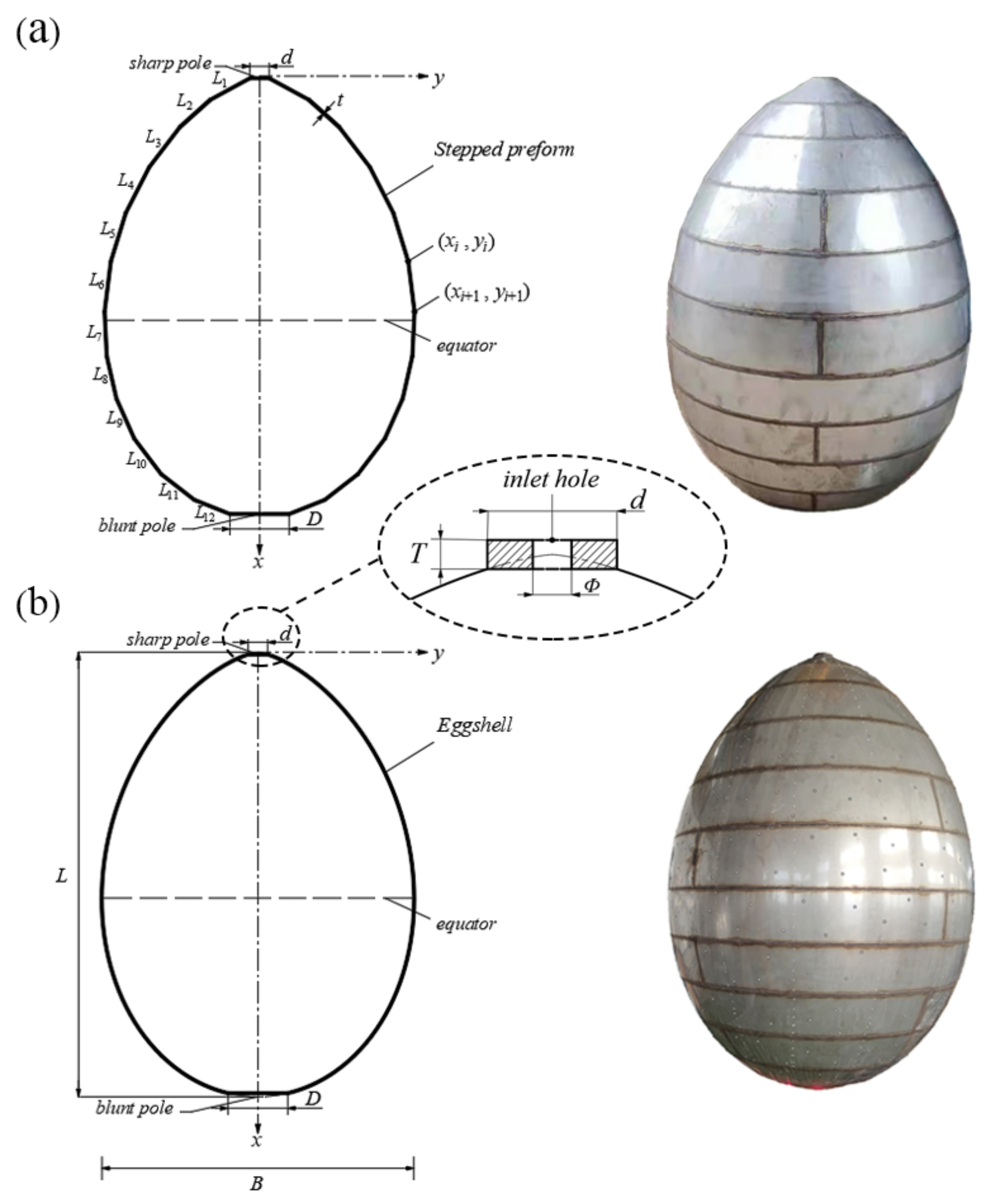

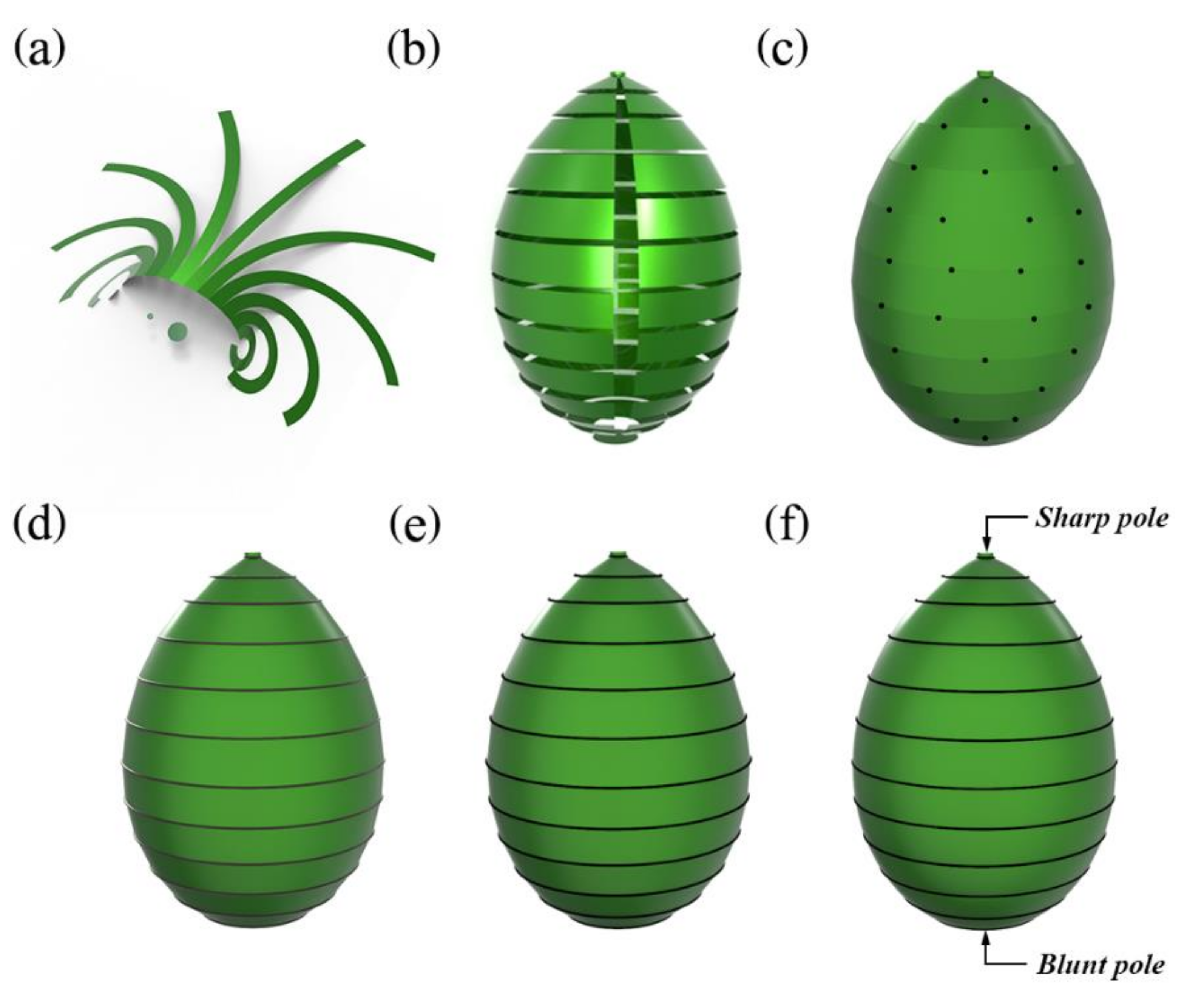
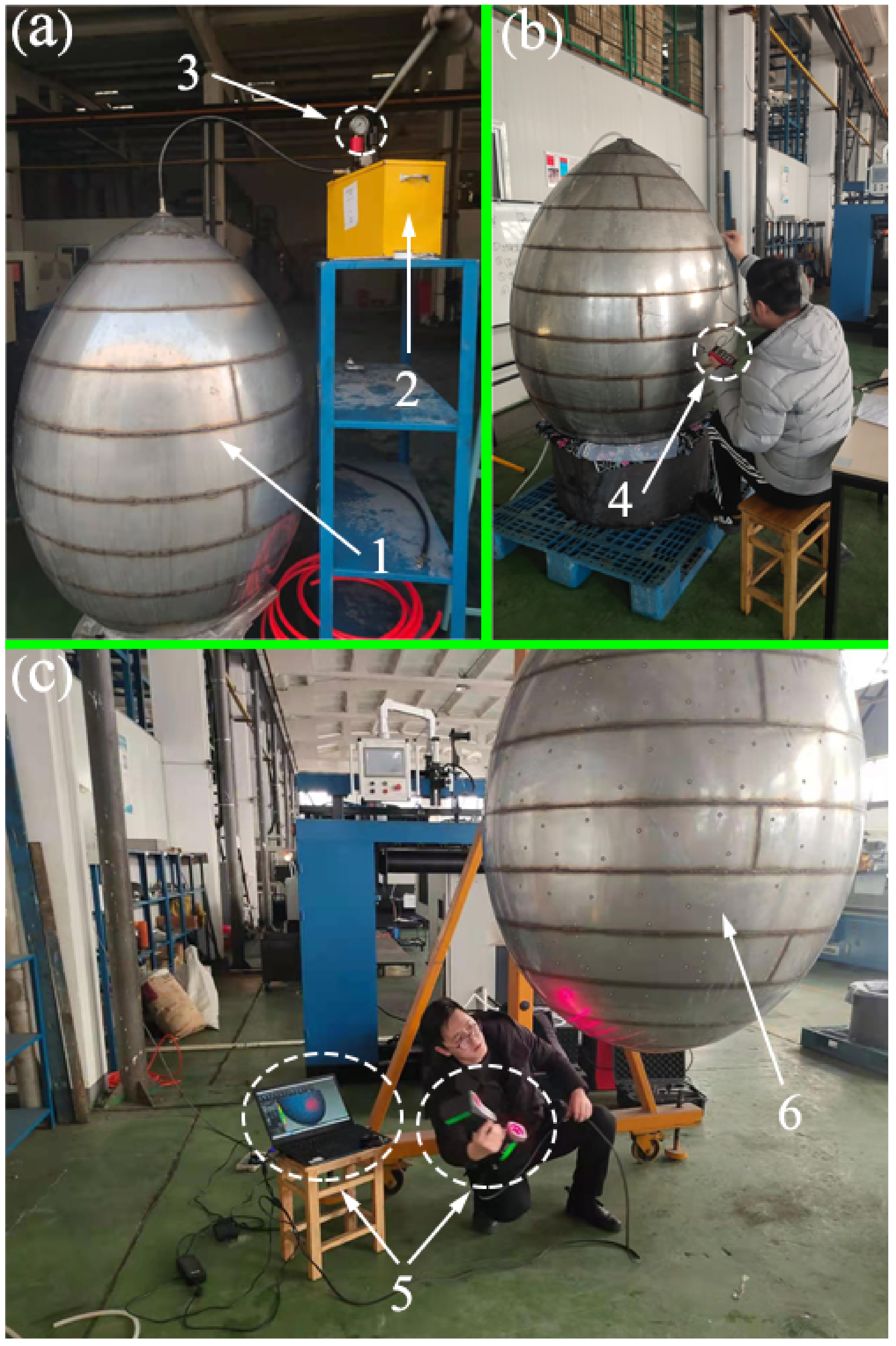
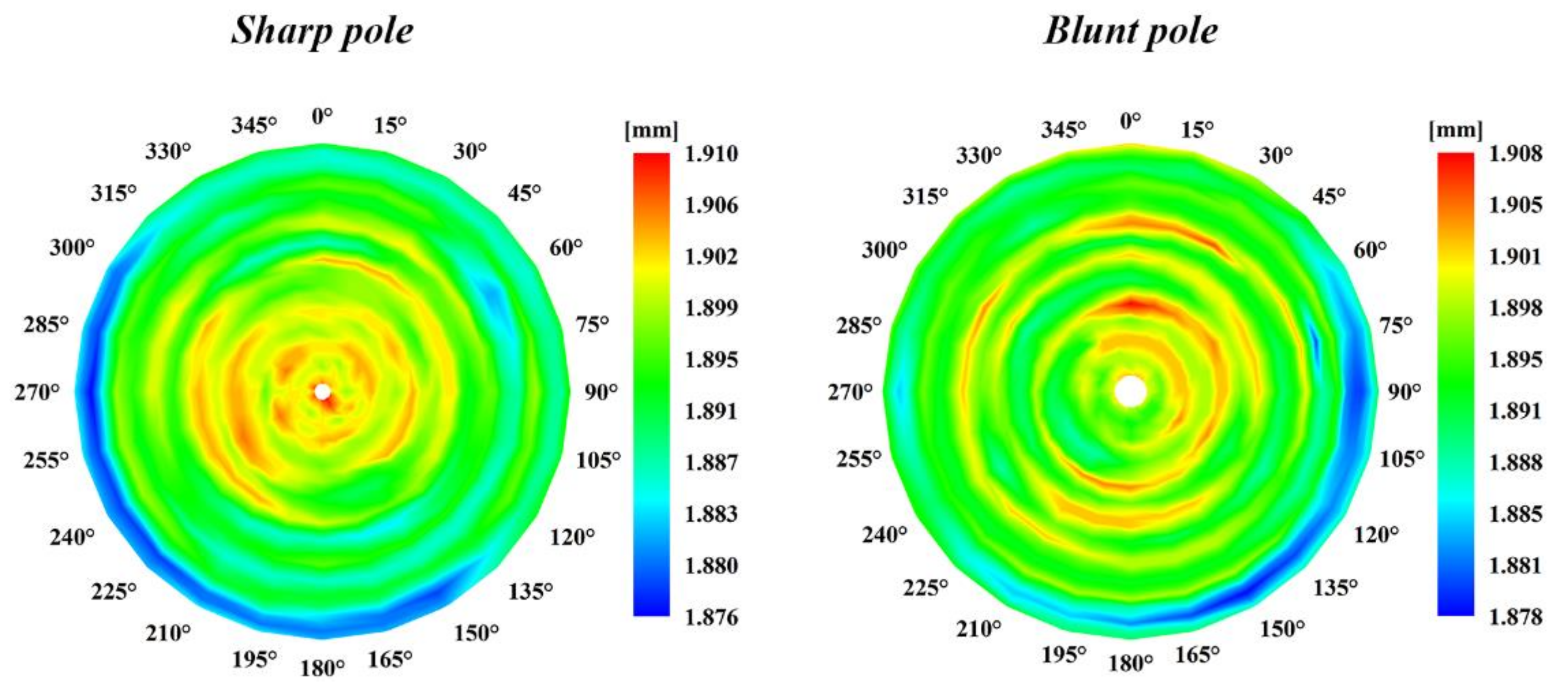

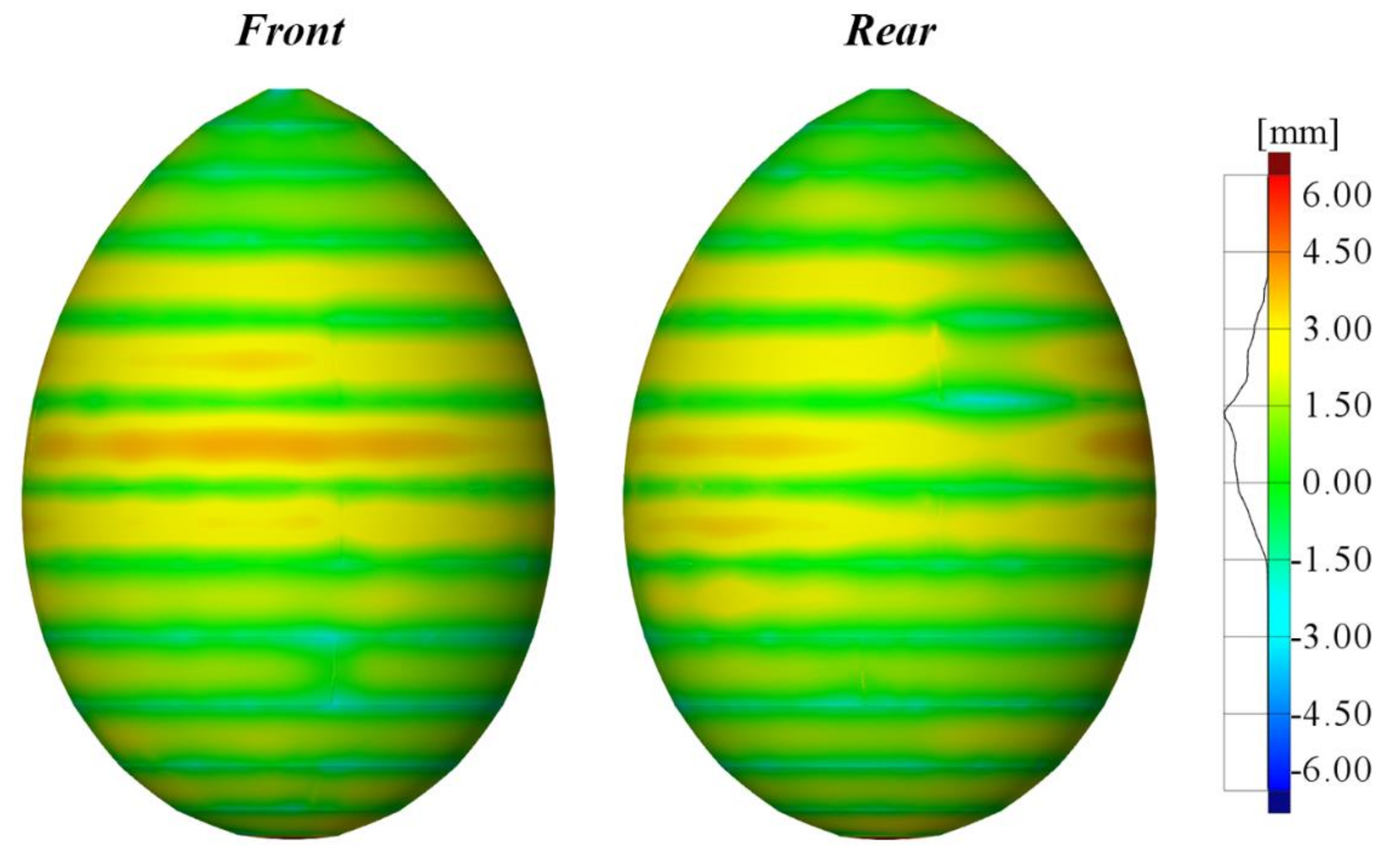

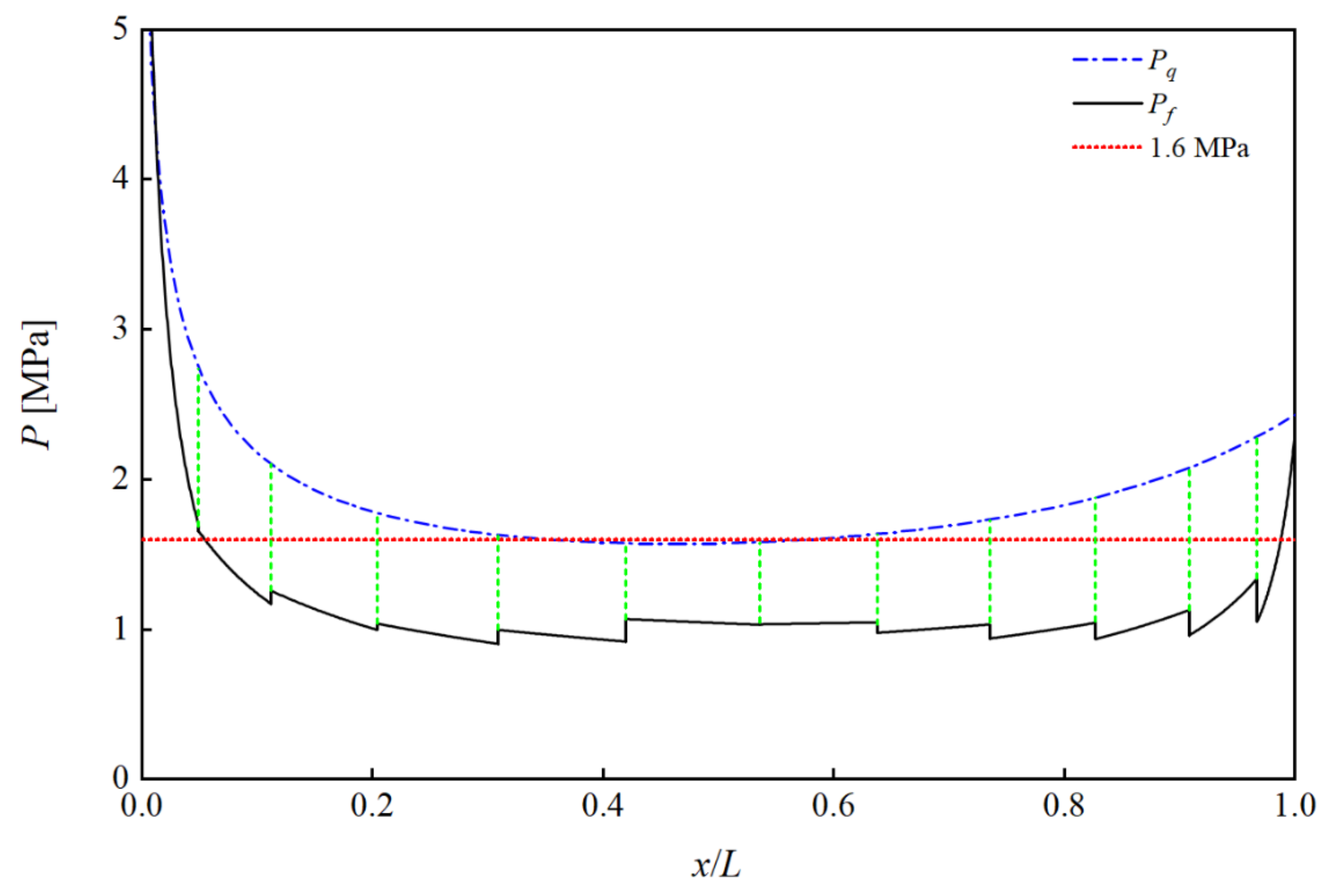
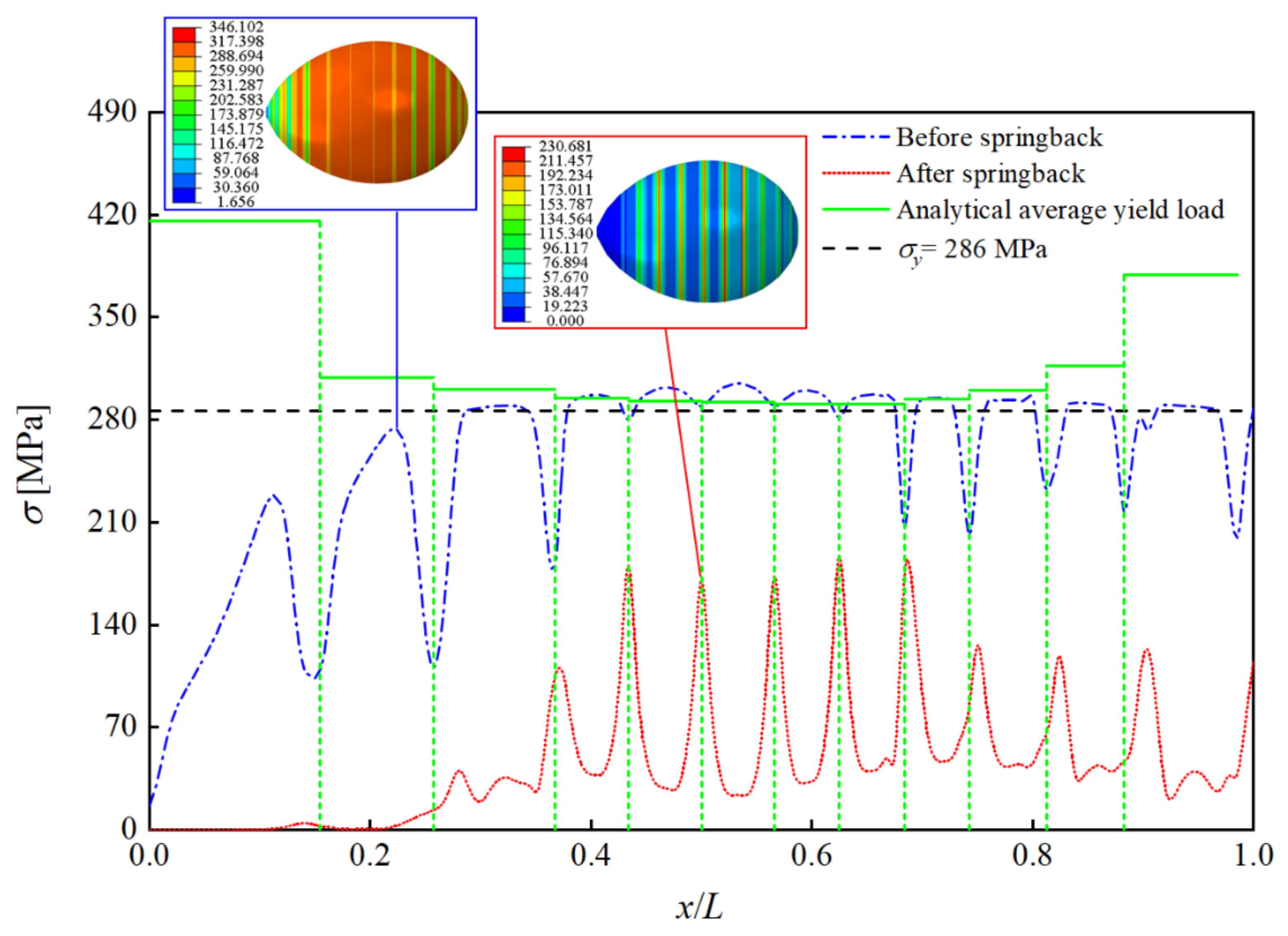
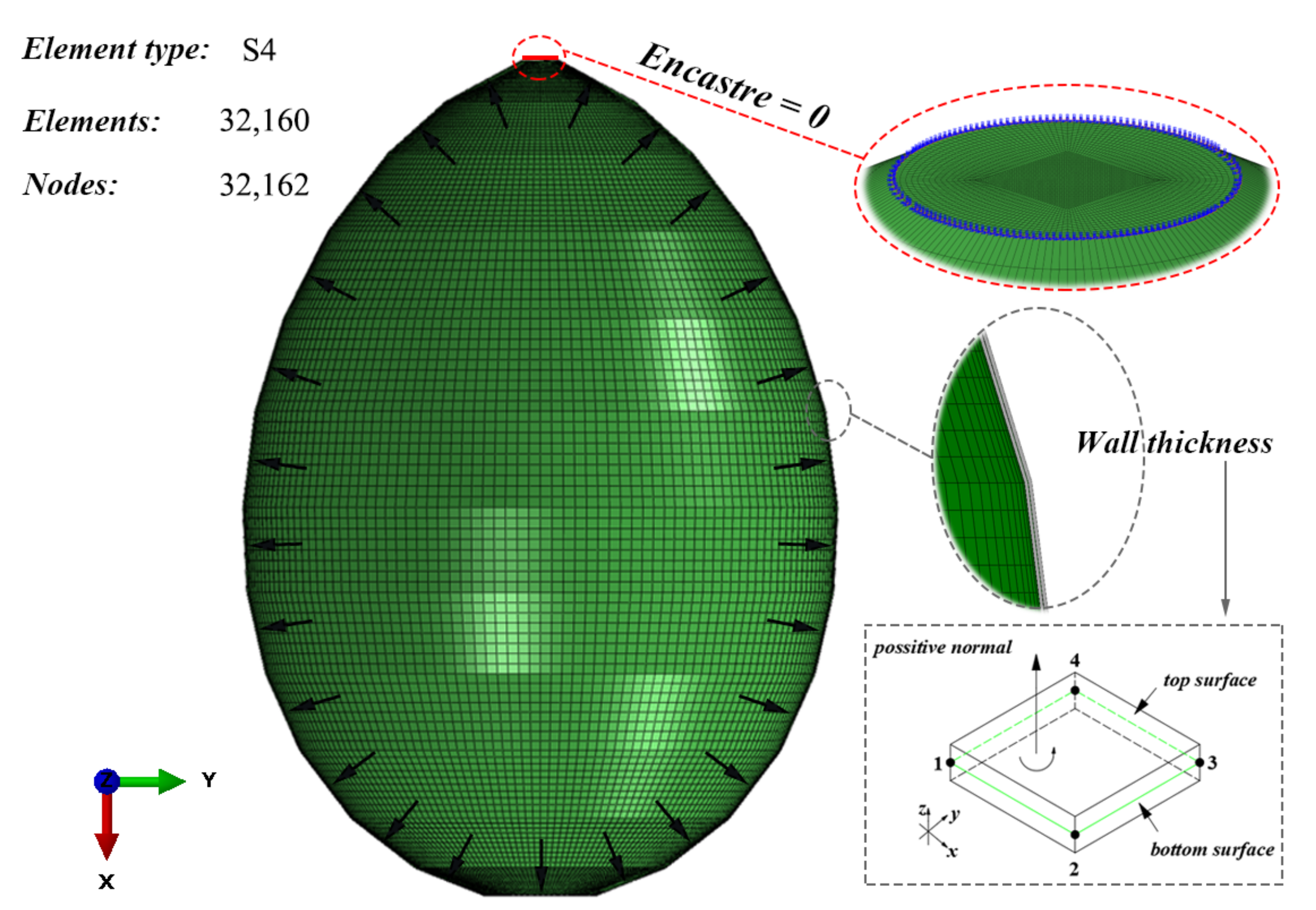

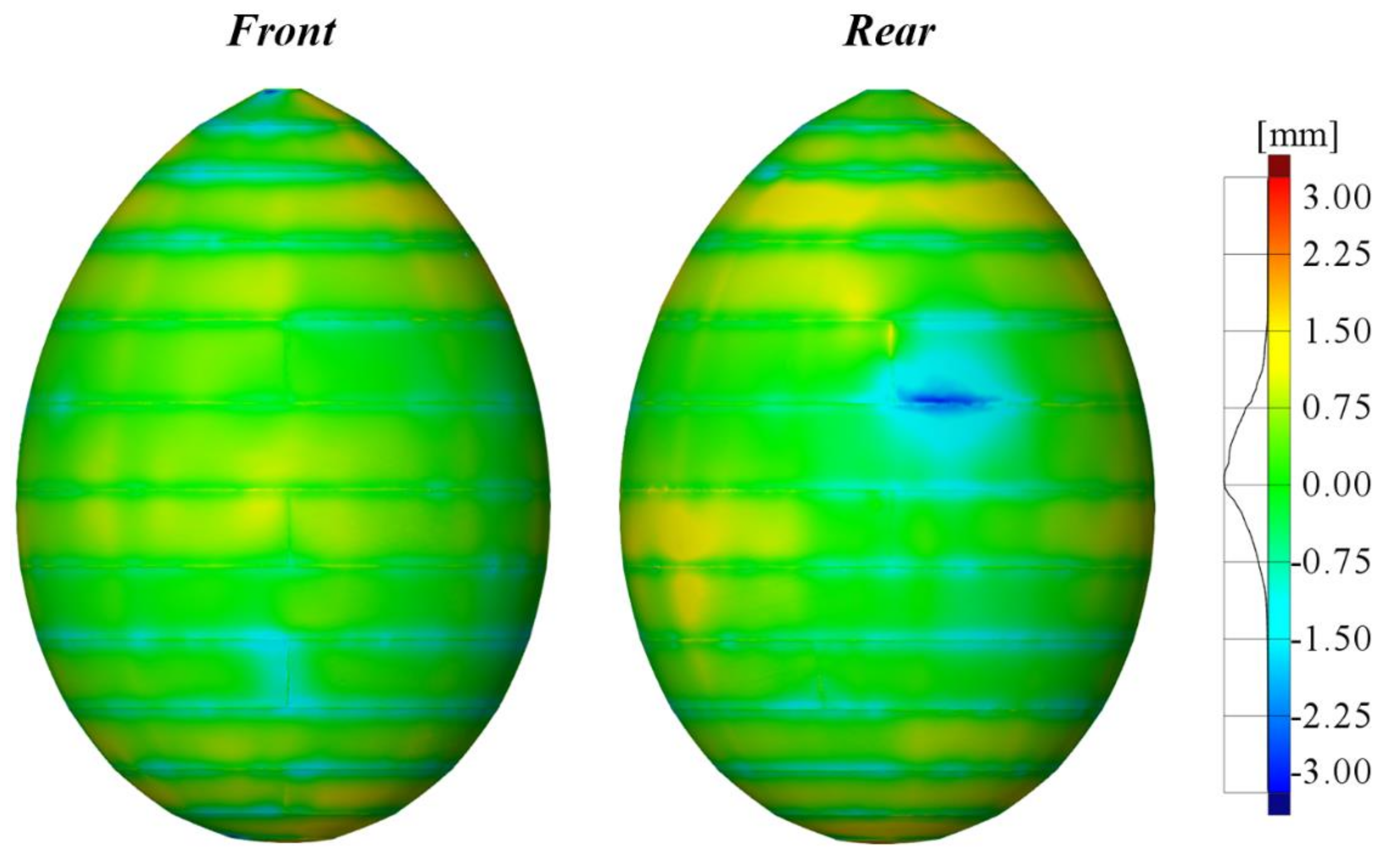

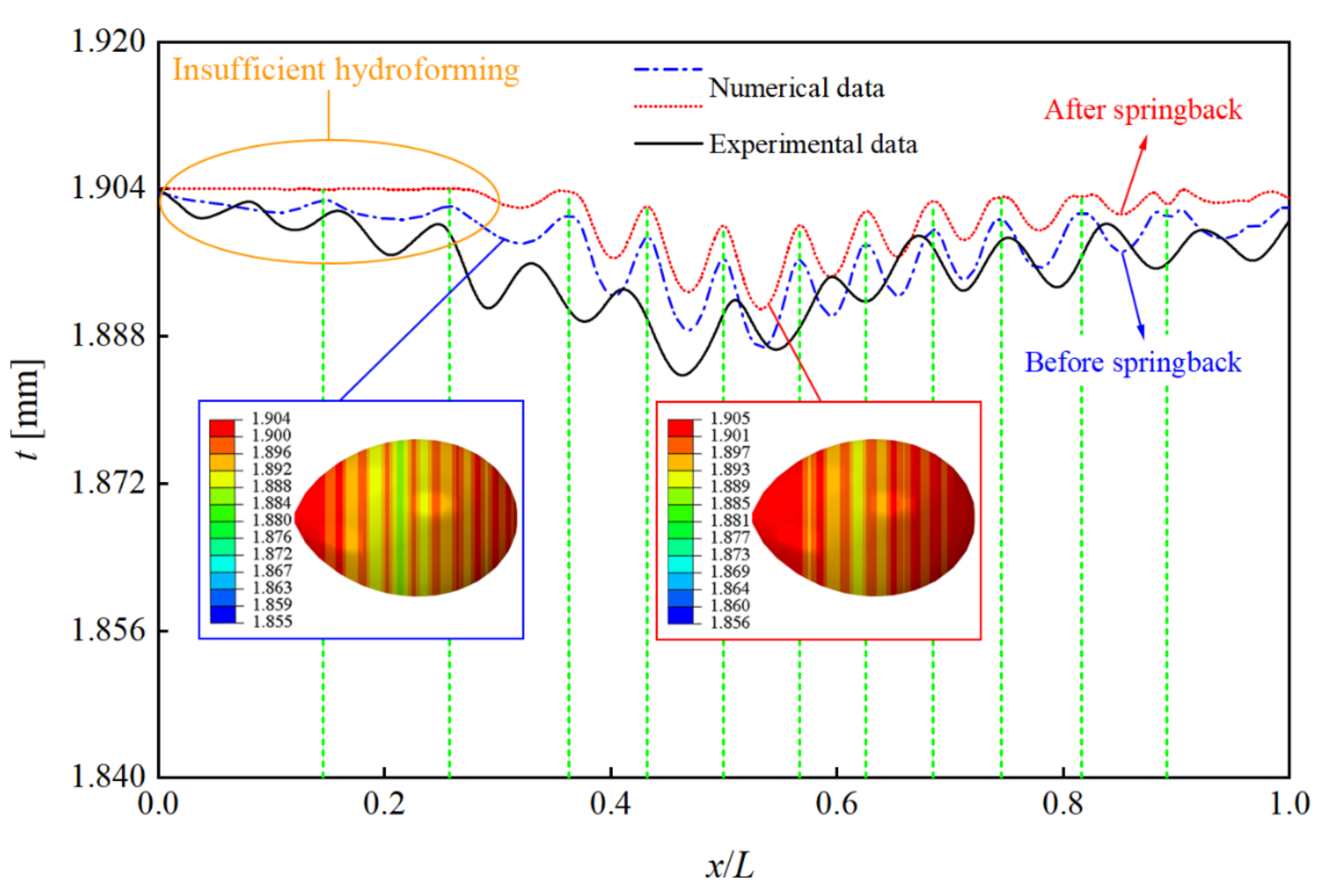

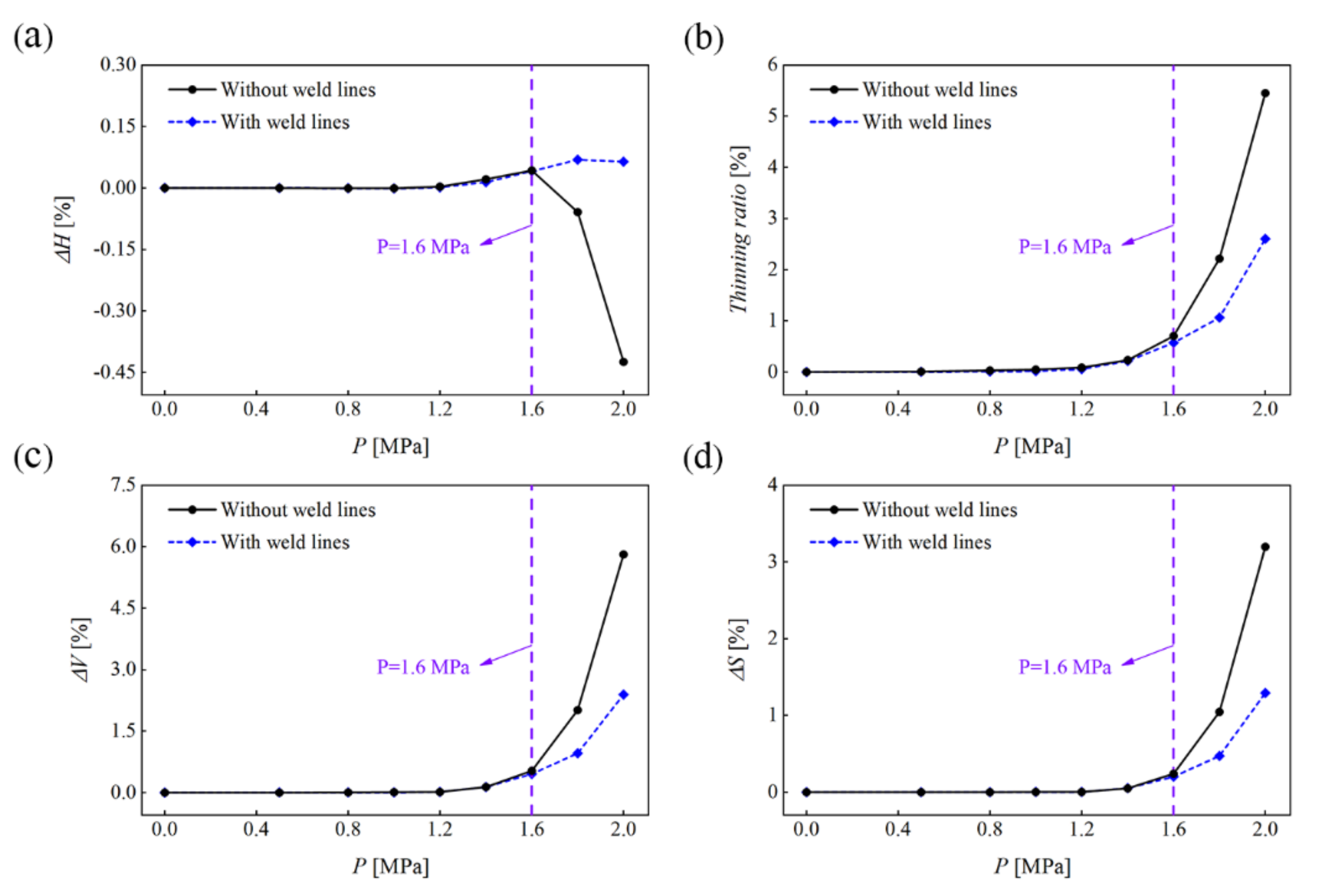
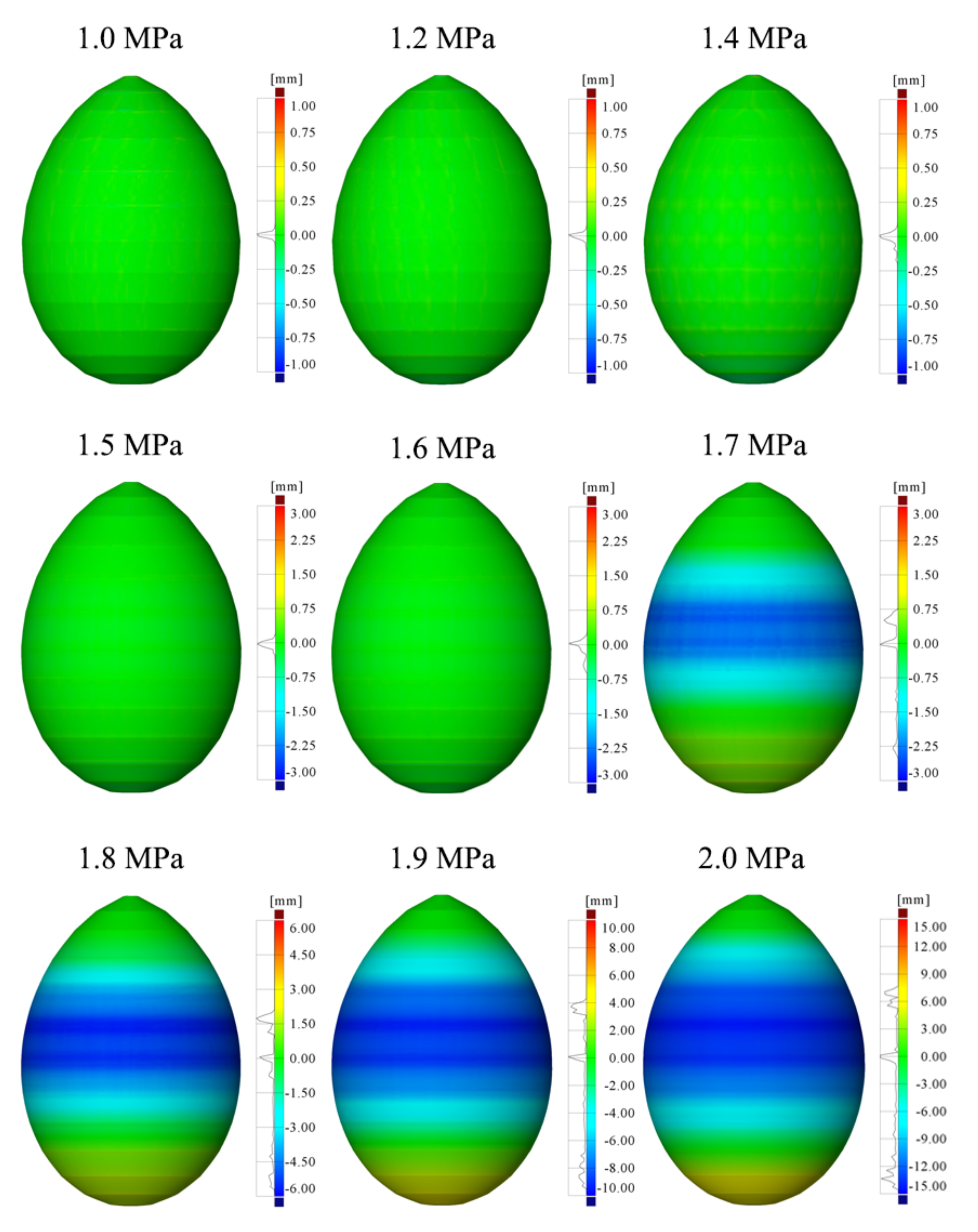
| Segment | ki | bi (mm) |
|---|---|---|
| 1st | 1.84 | 33.51 |
| 2nd | 1.11 | 88.39 |
| 3rd | 0.76 | 146.7 |
| 4th | 0.51 | 225.96 |
| 5th | 0.31 | 320.97 |
| 6th | 0.13 | 437.5 |
| 7th | −0.05 | 578.8 |
| 8th | −0.23 | 752.2 |
| 9th | −0.45 | 995.77 |
| 10th | −0.76 | 1385.99 |
| 11th | −1.29 | 2116.03 |
| 12th | −2.51 | 3909.19 |
| Parameters | Values (mm) |
|---|---|
| Minor axis of eggshell (B) | 1070 |
| Major axis of eggshell (L) | 1537 |
| Wall thickness of stepped preform (t) | 1.9 |
| Height of thick closure (T) | 10 |
| Diameter of thick closure (d) | 67 |
| Hole diameter (Φ) | 20 |
| Pole sheet diameter (D) | 206 |
| Meridian length of 1st segment of stepped preform (L1) | 157.3 |
| Meridian length of 2nd segment of stepped preform (L2) | 140.8 |
| Meridian length of 3rd segment of stepped preform (L3) | 176.8 |
| Meridian length of 4th segment of stepped preform (L4) | 179.0 |
| Meridian length of 5th segment of stepped preform (L5) | 176.2 |
| Meridian length of 6th segment of stepped preform (L6) | 176.5 |
| Meridian length of 7th segment of stepped preform (L7) | 155.1 |
| Meridian length of 8th segment of stepped preform (L8) | 152.0 |
| Meridian length of 9th segment of stepped preform (L9) | 152.4 |
| Meridian length of 10th segment of stepped preform (L10) | 154.9 |
| Meridian length of 11th segment of stepped preform (L11) | 145.9 |
| Meridian length of 12th segment of stepped preform (L12) | 133.6 |
| Segment | Si0 (mm2) | Si1 (mm2) | Vi0 (mm3) | Vi1 (mm3) | Hi (mm) |
|---|---|---|---|---|---|
| 1st | 101,435 | 103,814 | 2,857,513 | 3,278,619 | 75.05 |
| 2nd | 198,271 | 199,794 | 15,125,846 | 15,547,038 | 94.16 |
| 3rd | 366,836 | 369,852 | 48,490,680 | 49,519,885 | 140.30 |
| 4th | 477,599 | 480,859 | 90,600,147 | 91,862,411 | 159.37 |
| 5th | 543,926 | 547,259 | 127,829,647 | 129,203,572 | 168.35 |
| 6th | 585,752 | 589,415 | 153,553,684 | 155,094,384 | 175.08 |
| 7th | 521,791 | 524,534 | 139,565,774 | 140,706,599 | 154.88 |
| 8th | 491,609 | 494,457 | 123,468,732 | 124,612,009 | 148.15 |
| 9th | 447,171 | 450,316 | 95,529,255 | 96,722,333 | 139.17 |
| 10th | 378,675 | 382,145 | 59,089,901 | 60,310,434 | 123.46 |
| 11th | 261,032 | 263,730 | 23,190,990 | 24,065,192 | 89.49 |
| 12th | 138,611 | 140,049 | 4,493,564 | 4,929,671 | 49.47 |
| Segment | εt | εθ | εφ | εeq | σy (MPa) |
|---|---|---|---|---|---|
| 1st | −0.0232 | 0.0689 | −0.0456 | 0.0997 | 416 |
| 2nd | −0.0077 | 0.0137 | −0.0061 | 0.0176 | 309 |
| 3rd | −0.0082 | 0.0105 | −0.0023 | 0.0118 | 301 |
| 4th | −0.0068 | 0.0069 | −0.0001 | 0.0070 | 295 |
| 5th | −0.0061 | 0.0053 | 0.0008 | 0.0050 | 293 |
| 6th | −0.0062 | 0.0050 | 0.0012 | 0.0045 | 292 |
| 7th | −0.0052 | 0.0041 | 0.0012 | 0.0036 | 291 |
| 8th | −0.0058 | 0.0046 | 0.0012 | 0.0041 | 291 |
| 9th | −0.0070 | 0.0062 | 0.0008 | 0.0058 | 294 |
| 10th | −0.0091 | 0.0102 | −0.0011 | 0.0108 | 300 |
| 11th | −0.0103 | 0.0185 | −0.0082 | 0.0237 | 317 |
| 12th | −0.0103 | 0.0463 | −0.0360 | 0.0715 | 379 |
Disclaimer/Publisher’s Note: The statements, opinions and data contained in all publications are solely those of the individual author(s) and contributor(s) and not of MDPI and/or the editor(s). MDPI and/or the editor(s) disclaim responsibility for any injury to people or property resulting from any ideas, methods, instructions or products referred to in the content. |
© 2023 by the authors. Licensee MDPI, Basel, Switzerland. This article is an open access article distributed under the terms and conditions of the Creative Commons Attribution (CC BY) license (https://creativecommons.org/licenses/by/4.0/).
Share and Cite
Tang, Y.; Zhang, J.; Zhan, M.; Jiao, H.; Cheng, P.; Dai, M. Internal Hydroforming of Large Stainless-Steel Eggshells from Stepped Preforms. Metals 2023, 13, 1352. https://doi.org/10.3390/met13081352
Tang Y, Zhang J, Zhan M, Jiao H, Cheng P, Dai M. Internal Hydroforming of Large Stainless-Steel Eggshells from Stepped Preforms. Metals. 2023; 13(8):1352. https://doi.org/10.3390/met13081352
Chicago/Turabian StyleTang, Yinhui, Jian Zhang, Ming Zhan, Huifeng Jiao, Peng Cheng, and Mingqiang Dai. 2023. "Internal Hydroforming of Large Stainless-Steel Eggshells from Stepped Preforms" Metals 13, no. 8: 1352. https://doi.org/10.3390/met13081352





